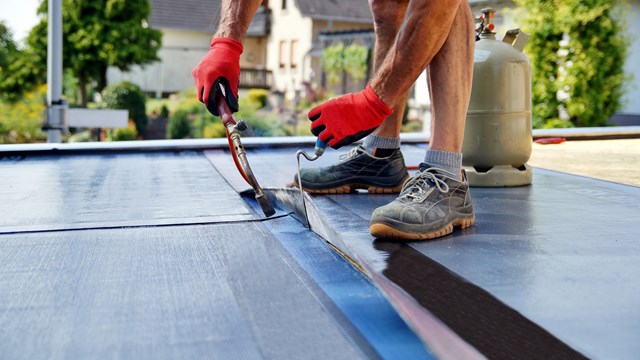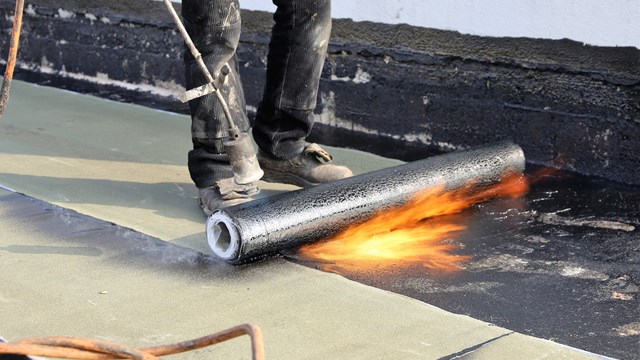Few sounds are as bone-chilling as an ominous and unexpected series of drips in the twilight hours, the eerily melodic tone of water trickling in through a window, the ceiling or any other part of one’s condominium that was designed to remain dry.
From rooftops to basements and all spaces in between, water can pose a serious risk to the structural and aesthetic health of a building or a home. This is why architects, builders and engineers commit so much time, energy, and resources to sealing and waterproofing a building.
“A property is fully waterproofed once all of its components have been installed and are working together as a system to keep water out,” says Scott Baryiewski, vice president of South Shore Construction in Woodbridge.
“This includes the foundation, air barriers, roofing membranes, windows, flashing, and other façade elements. The actual work is done in stages by various contractors as a building is being constructed. For example, the foundation must be waterproofed before it can be back-filled, and an air and vapor barrier must be installed before the façade component can be put in place.”
These waterproofing activities are focused on the most vulnerable aspects of a building, including the roof, the likeliest contender for trouble.
The Proof is in the Sealant
There are three main systems for waterproofing, according to Brian Keenan, business development manager of Valcourt Building Services in Millstone. The first two are sealants (usually made of silicone or polyurethane) and coatings, which are fairly self-explanatory, and then flashings, which are a little less evident to the layman. Flashing tape is used to secure a window on a brick façade. As brick is porous, flashings are required to allow water to actually go into a building’s envelope and then be routed back out, and is usually installed at the top of the window. When dealing with vinyl or wooden siding, flashings are unnecessary.
Baryiewski adds that other specific methods and materials that contractors use to seal up buildings, in regard to both existing structures and new construction, include water repellents, caulk and the replacement of failed exterior elements (i.e. repointing mortars or replacing masonry, etc.) to halt water penetration into a property.
David Leger, CAM, service manager for association management leader Associa, which has two office locations in New Jersey, believes that “age is the most common cause of roof leaks. Roofs wear out. They are the one part of the building that endures the most dramatic elements. In the north, ice will tear a roof apart, and in the south, the sun’s UV rays will deteriorate a lot of roof systems.”
Keenan, whose company does not work on roofs, sees a lot of leakage around the windows. He describes two different types of sealant failure: adhesive and cohesive. The latter is simple decomposition, while the former involves a product failing to stick to what it’s intended. To avoid this, he recommends installing carefully, according to manufacturer specifications, and, when dealing with a restoration project, ensure that the surface to which a product is being applied has been fully cleaned, so that it’s not simply being placed over some grime or an older version of the product.
Aside from roofs and windows, basements can pose significant waterproofing challenges as well, arising from several potential conditions, including failures in the very structure of the property itself.
“In regard to the foundation, cracks are the most common cause of water entry, but honeycombs—bad foundation pours that did not set properly—can also pose a problem,” says Bob Shipyor, director of sales and marketing for Ram-Jack Safeguard Waterproofing, which has a nearby location in Newtown Square, Pennsylvania. “Tie rods, pipe penetrations, window wells, cold pour joints, and cove leaks are other trouble spots.”
Baryiewski agrees on the vulnerability of roofs, and asserts that anywhere one can expect to find caulking is also perishable. “The exterior skin of buildings, if installed properly, are meant to last many years before requiring repair or replacement,” he says. “When a building develops leaks, it can be due to a variety of reasons. Leaks early on in a building’s life are usually caused by poor construction or design, while leaks that develop later are usually due to deterioration from weather and the age of the materials. Roof leaks, especially those located away from an exterior wall, typically appear at the top floor of the structure. Leaks at an exterior wall typically show up at windows and are related to failed caulk joints or ineffective flashings. There may also be other failed exterior components in the vicinity of the leak which allowed the water to penetrate the envelope from the beginning. Keep in mind that water follows the path of least resistance, so it can occasionally show up far from its infiltration point.”
Soluble Solutions
When water makes a sudden and unwelcome appearance in a structure, one’s first instinct may be to panic. The proper course of action—as is often the case—is not to panic but to call in an expert to evaluate the situation, determine a cause for the leak, and then put together the best possible course of action to fix the issue. Often, finding the source of these problems can be more difficult than solving the actual problems themselves.
Usually, it’s wise to reach out to a professional before a leak is evident, just to make sure that the work currently being done to maintain a property is on the up-and-up.
“Hiring a professional waterproofer to do an annual walk-around or punch list is always worth it,” says Keenan. It helps create a steadier maintenance budget if a professional advises a board or management, and it can keep costs down in the long run.
Keenan also advises that an association make occasional visual inspections and walk-throughs on its own. These tours should include checking doors, windows and light fixtures to make sure they’re adequately sealed, and to look for any exterior discoloration. He advocates sending a survey out to residents, as “everyone’s threshold in regard to when they’ll report something is different. People are less likely to call for help as they are to check a box, and some people won’t report a leak at all until it’s already doing costly damage to a property.”
Professional waterproofers are also significantly more able to identify leaks that are not glaringly obvious to the average condominium board member.
Baryiewski explains how he “makes openings at the interior or exterior of a building where a leak may be occurring in order to understand any deficiencies that may have caused the leak. Exterior components have a limited service life due to their exposure to the elements. Another way to identify problems is by water testing, whereby one isolates a specific area and applies water pressure to the exterior building components to locate at which point water is penetrating the building. Many times portions of the interior or exterior must be removed after the leak is identified to determine the source of the problem.”
Once the root source of a problem is identified, attention can be turned toward solving that issue and preventing it from happening again. “When a roof leaks, the cause of the leak as well as the type of roof system will determine the best fix,” says Leger. Assessments and evaluations are best made by an expert in the field, rather than by in-house staff.
For basement water issues, the solution “can be as simple as an epoxy injection for a foundation wall crack to a drain tile system for a more serious cove leak,” says Shipyor.
And in the case of the most severe leakage, Keenan strongly recommends calling in an engineer for an invasive exploration to assess the price level of the damage and the repairs.
For basements, experts suggest a backup to the building’s sump pump, in addition to a generator or substantial backup battery in the event that the building loses electricity, which happens in many heavy rainstorms.
Once a foolproof system is in place, however, maintain it; continue operating it smoothly with regular inspections, evaluations, and maintenance—and an eye on the foundation, especially for cracks. Without a doubt, regular inspections can save ample amounts of money in the long run.
There are numerous professional experts in various industries and fields who are almost always ready to extend a helping hand to an association when a water emergency strikes unexpectedly.
As the old adage goes, however, “a stitch in time saves nine.” The best way to avoid problems with water infiltration is to ensure that initial waterproofing is done properly and maintained properly throughout the life of a structure. Prevention and planning will always go a long way toward preserving an association’s property.
Mike Odenthal is a staff writer at The New Jersey Cooperator. Freelance writer Elizabeth Lent contributed to this article.







Leave a Comment